Numerical Study of the Energy Flow Characteristics of Multi-Stage Pump as Turbines
Abstract
:1. Introduction
2. Methodology
2.1. Definition of Hydraulic Loss
2.2. Entropy Production Theory
2.3. Pearson Correlation Coefficient and p-Value
3. Experimental Research
3.1. Experimental Setup and Process
3.2. Geometric Parameters
4. Numerical Analysis
4.1. Computational Model and Mesh Generation
4.2. Solution Modeling
4.3. Comparison of Experimental and Numerical Simulation Results
5. Energy Loss Analysis
5.1. Comparison of Energy Loss Calculation Methods
5.2. Distribution of Entropy Production of Each Component with Flow Rate
5.3. Distribution of Entropy Production in Flow Field
5.4. Correlation Analysis
6. Conclusions
- (1)
- Based on entropy production theory, the energy loss calculation method can statistically investigate each component of the multi-stage PAT. Unlike the traditional methods, entropy production theory can predict the locations where losses occurred accurately. The guide vane, impeller, inlet and outlet volute, front and back chambers, and the balance disc are the main sources of energy loss in multi-stage PAT. The total entropy production rate of the impellers and the guide vanes increases dramatically as the flow rate increases. The total entropy production rate of each component under design flow conditions is listed in decreasing order: impeller, guide vane, front and back chamber, a balance disk, and inlet and outlet volute. The energy loss is commonly observed near the leading edge of both the impeller blades and the positive guide vanes. The entropy production of each factor is referenced in decreasing order as turbulent entropy production, wall entropy production, and direct entropy production. The entire energy loss is larger at the first stage because there is no reverse guide vane. The entropy production rate of each impeller is not clearly distinguishable. Therefore, using the entropy production theory can effectively identify the characteristics of the flow field and the location of energy losses. It provides a reference for the targeted optimization of multi-stage PAT.
- (2)
- The flow domain versus entropy production of impellers and guide vanes indicates that the energy loss is closely related to other physical quantities in the flow domain. The distributions of streamlines with the impellers and guide vanes versus VEPR prove that higher relative velocity accompanies larger energy loss. Furthermore, the distribution of streamlines and vortex cores at the impellers reflects that flow domain stability increases from the first stage impeller to the fifth stage impeller. When the distributions of WEPR and skin friction coefficient at the impeller are compared, the WEPR is discovered to be significantly relevant to the wall friction distribution.
- (3)
- There is a correlation between hydraulic loss and entropy production. The Pearson correlation coefficient is used to evaluate the relationship between the hydraulic loss and entropy production of the impellers. According to the findings, viscous entropy production has the strongest correlation with the dissipation effect, followed by turbulent entropy, total entropy, and wall entropy. The dissipation and transportation effects are also strongly associated.
Author Contributions
Funding
Data Availability Statement
Conflicts of Interest
References
- Nautiyal, H.; Varun, V.; Kumar, A.; Yadav, S.Y.S. Experimental Investigation of Centrifugal Pump Working as Turbine for Small Hydropower Systems. Energy Sci. Technol. 2011, 1, 79–86. [Google Scholar]
- Derakhshan, S.; Nourbakhsh, A. Theoretical, numerical and experimental investigation of centrifugal pumps in reverse operation. Exp. Therm. Fluid Sci. 2008, 32, 1620–1627. [Google Scholar] [CrossRef]
- Derakhshan, S.; Nourbakhsh, A. Experimental study of characteristic curves of centrifugal pumps working as turbines in different specific speeds. Exp. Therm. Fluid Sci. 2007, 32, 800–807. [Google Scholar] [CrossRef]
- Williams, A.A. The Turbine Performance of Centrifugal Pumps: A Comparison of Prediction Methods. Proc. Inst. Mech. Eng. Part A J. Power Energy 1994, 208, 59–66. [Google Scholar] [CrossRef]
- Huang, S.; Qiu, G.; Su, X.; Chen, J.; Zou, W. Performance prediction of a centrifugal pump as turbine using rotor-volute matching principle. Renew. Energy 2017, 108, 64–71. [Google Scholar] [CrossRef]
- Mdee, O.J.; Kimambo, C.Z.; Nielsen, T.K.; Kihedu, J. Analytical Evaluation of Head and Flow Rate Off-Design Characteristics for Pump as Turbine Application. J. Fluids Eng. 2019, 141, 051203. [Google Scholar] [CrossRef]
- Wang, T.; Wang, C.; Kong, F.; Gou, Q.; Yang, S. Theoretical, experimental, and numerical study of special impeller used in turbine mode of centrifugal pump as turbine. Energy 2017, 130, 473–485. [Google Scholar] [CrossRef]
- Liu, M.; Tan, L.; Cao, S. Theoretical model of energy performance prediction and BEP determination for centrifugal pump as turbine. Energy 2019, 172, 712–732. [Google Scholar] [CrossRef]
- Yang, S.-S.; Derakhshan, S.; Kong, F.-Y. Theoretical, numerical and experimental prediction of pump as turbine performance. Renew. Energy 2012, 48, 507–513. [Google Scholar] [CrossRef]
- Shi, G.; Liu, X.; Wang, Z.; Liu, Y. Conversion relation of centrifugal pumps as hydraulic turbines based on the amplification coefficient. Adv. Mech. Eng. 2017, 9, 299–307. [Google Scholar] [CrossRef]
- Rossi, M.; Renzi, M. Analytical Prediction Models for Evaluating Pumps-As-Turbines (PaTs) Performance. Energy Procedia 2017, 118, 238–242. [Google Scholar] [CrossRef]
- Rossi, M.; Renzi, M. A general methodology for performance prediction of pumps-as-turbines using Artificial Neural Networks. Renew. Energy 2018, 128, 265–274. [Google Scholar] [CrossRef]
- Frosina, E.; Buono, D.; Senatore, A. A Performance Prediction Method for Pumps as Turbines (PAT) Using a Computational Fluid Dynamics (CFD) Modeling Approach. Energies 2017, 10, 103. [Google Scholar] [CrossRef] [Green Version]
- Yang, S.S.; Kong, F.Y.; Qu, X.Y.; Jiang, W.M. Influence of Blade Number on the Performance and Pressure Pulsations in a Pump Used as a Turbine. J. Fluids Eng. 2012, 134, 124503. [Google Scholar] [CrossRef]
- Yang, S.-S.; Kong, F.Y.; Jiang, W.M.; Qu, X.Y. Effects of impeller trimming influencing pump as turbine. Comput. Fluids 2012, 67, 72–78. [Google Scholar] [CrossRef]
- Yang, S.S.; Liu, H.L.; Kong, F.Y.; Dai, C.; Dong, L. Experimental, Numerical, and Theoretical Research on Impeller Diameter Influencing Centrifugal Pump-as-Turbine. J. Energy Eng. 2013, 139, 299–307. [Google Scholar] [CrossRef]
- Yang, S.S.; Liu, H.L.; Kong, F.Y.; Xia, B.; Tan, L.W. Effects of the Radial Gap Between Impeller Tips and Volute Tongue Influencing the Performance and Pressure Pulsations of Pump as Turbine. J. Fluids Eng. 2014, 136, 054501. [Google Scholar] [CrossRef]
- Yang, S.S.; Wang, C.; Chen, K.; Yuan, X. Research on Blade Thickness Influencing Pump as Turbine. Adv. Mech. Eng. 2014, 6, 841–868. [Google Scholar] [CrossRef]
- Miao, S.C.; Yang, J.H.; Shi, G.T.; Wang, T.T. Blade profile optimization of pump as turbine. Adv. Mech. Eng. 2015, 7, 1687814015605748. [Google Scholar] [CrossRef] [Green Version]
- Shi, F.; Yang, J.; Wang, X. Analysis on the effect of variable guide vane numbers on the performance of pump as turbine. Adv. Mech. Eng. 2018, 10, 168781401878079. [Google Scholar] [CrossRef]
- Delgado, J.; Ferreira, J.P.; Covas, D.I.C.; Avellan, F. Variable speed operation of centrifugal pumps running as turbines. Experimental investigation. Renew. Energy 2019, 142, 437–450. [Google Scholar] [CrossRef]
- Xia, S.F.; Hu, Y.J.; Hui, W.X. Effect of Rotating Speed on Hydraulic Energy Recovery Turbines Performance. Appl. Mech. Mater. 2013, 444–445, 1033–1037. [Google Scholar]
- Binama, M.; Su, W.T.; Cai, W.H.; Li, X.B.; Muhirwa, A.; Li, B.; Bisengimana, E. Blade trailing edge position influencing pump as turbine (PAT) pressure field under part-load conditions. Renew. Energy 2019, 136, 33–47. [Google Scholar] [CrossRef]
- Jain, S.V.; Patel, N.K.; Patel, R.N. Experimental Investigations of Cavitation Characteristics of Pump Running in Turbine Mode. J. Energy Eng. 2016, 143, 04016034. [Google Scholar] [CrossRef]
- Li, W.; Zhang, Y. Numerical simulation of cavitating flow in a centrifugal pump as turbine. Proc. Inst. Mech. Eng. Part E J. Process Mech. Eng. 2018, 232, 135–154. [Google Scholar] [CrossRef]
- Li, W.-G. Effects of viscosity on turbine mode performance and flow of a low specific speed centrifugal pump. Appl. Math. Model. 2016, 40, 904–926. [Google Scholar] [CrossRef]
- Abazariyan, S.; Rafee, R.; Derakhshan, S. Experimental study of viscosity effects on a pump as turbine performance. Renew. Energy 2018, 127, 539–547. [Google Scholar] [CrossRef]
- Stefanizzi, M.; Torresi, M.; Fornarelli, F.; Fortunato, B.; Camporeale, S.M. Performance prediction model of multistage centrifugal Pumps used as Turbines with Two-Phase Flow. Energy Procedia 2018, 148, 408–415. [Google Scholar] [CrossRef]
- Fengxia, S.; Junhu, Y.; Senchun, M.; Xiaohui, W. Investigation on the power loss and radial force characteristics of pump as turbine under gas–liquid two-phase condition. Adv. Mech. Eng. 2019, 11, 1687814019843732. [Google Scholar] [CrossRef] [Green Version]
- Qian, B.; Chen, J.P.; Wu, P.; Wu, D.Z.; Yan, P.; Li, S.Y. Investigation on inner flow quality assessment of centrifugal pump based on Euler head and entropy production analysis. In IOP Conference Series: Earth and Environmental Science; IOP Publishing: Bristol, UK, 2019; Volume 240, p. 092001. [Google Scholar]
- Wilhelm, S.; Balarac, G.; Métais, O.; Ségoufin, C. Analysis of Head Losses in a Turbine Draft Tube by Means of 3D Unsteady Simulations. Flow Turbul. Combust. 2016, 97, 1255–1280. [Google Scholar] [CrossRef] [Green Version]
- Hou, H.; Zhang, Y.; Li, Z.; Jiang, T.; Zhang, J.; Xu, C. Numerical analysis of entropy production on a LNG cryogenic submerged pump. J. Nat. Gas Sci. Eng. 2016, 36, 87–96. [Google Scholar] [CrossRef]
- Zhang, F.; Appiah, D.; Hong, F.; Zhang, J.; Yuan, S.; Adu-Poku, K.A.; Wei, X. Energy loss evaluation in a side channel pump under different wrapping angles using entropy production method. Int. Commun. Heat Mass Transf. 2020, 113, 104526. [Google Scholar] [CrossRef]
- Ji, L.; Li, W.; Shi, W.; Tian, F.; Agarwal, R. Diagnosis of internal energy characteristics of mixed-flow pump within stall region based on entropy production analysis model. Int. Commun. Heat Mass Transf. 2020, 117, 104784. [Google Scholar] [CrossRef]
- Ghorani, M.M.; Haghighi, M.H.S.; Riasi, A. Entropy generation minimization of a pump running in reverse mode based on surrogate models and NSGA-II. Int. Commun. Heat Mass Transf. 2020, 118, 104898. [Google Scholar] [CrossRef]
- Ji, L.; Li, W.; Shi, W.; Tian, F.; Agarwal, R. Effect of blade thickness on rotating stall of mixed-flow pump using entropy generation analysis. Energy 2021, 236, 121381. [Google Scholar] [CrossRef]
- Ji, L.; Li, W.; Shi, W.; Chang, H.; Yang, Z. Energy characteristics of mixed-flow pump under different tip clearances based on entropy production analysis. Energy 2020, 199, 117447. [Google Scholar] [CrossRef]
- Herwig, H.; Kock, F. Direct and indirect methods of calculating entropy generation rates in turbulent convective heat transfer problems. Heat Mass Transf. 2007, 43, 207–215. [Google Scholar] [CrossRef]
- Kock, F.; Herwig, H. Entropy production calculation for turbulent shear flows and their implementation in cfd codes. Int. J. Heat Fluid Flow 2005, 26, 672–680. [Google Scholar] [CrossRef]
- Zhang, X.; Wang, Y.; Xu, X.; Wang, H. Energy conversion characteristic within impeller of low specific speed centrifugal pump. Nongye Jixie Xuebao (Trans. Chin. Soc. Agric. Mach.) 2011, 42, 75–81. [Google Scholar]
- Duan, L.; Wu, X.; Ji, Z. Application of entropy generation method for analyzing energy loss of cyclone separator. CIESC J. 2014, 65, 583–592. [Google Scholar]

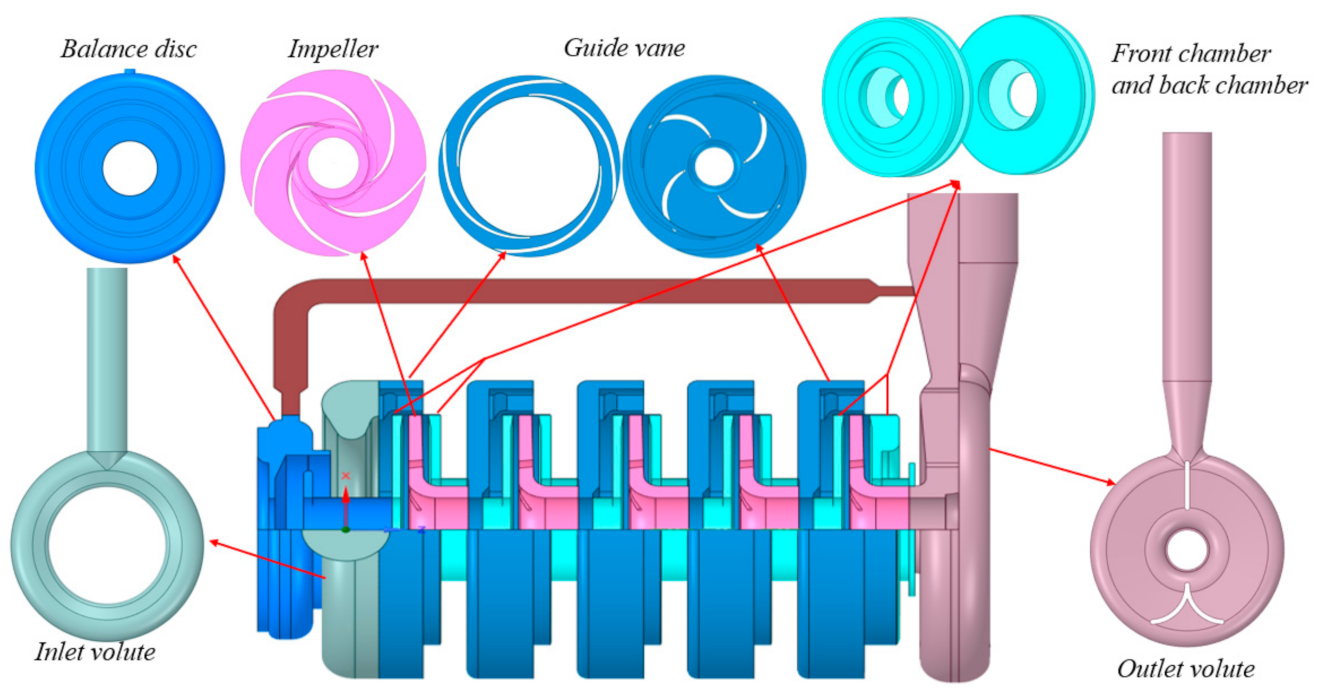
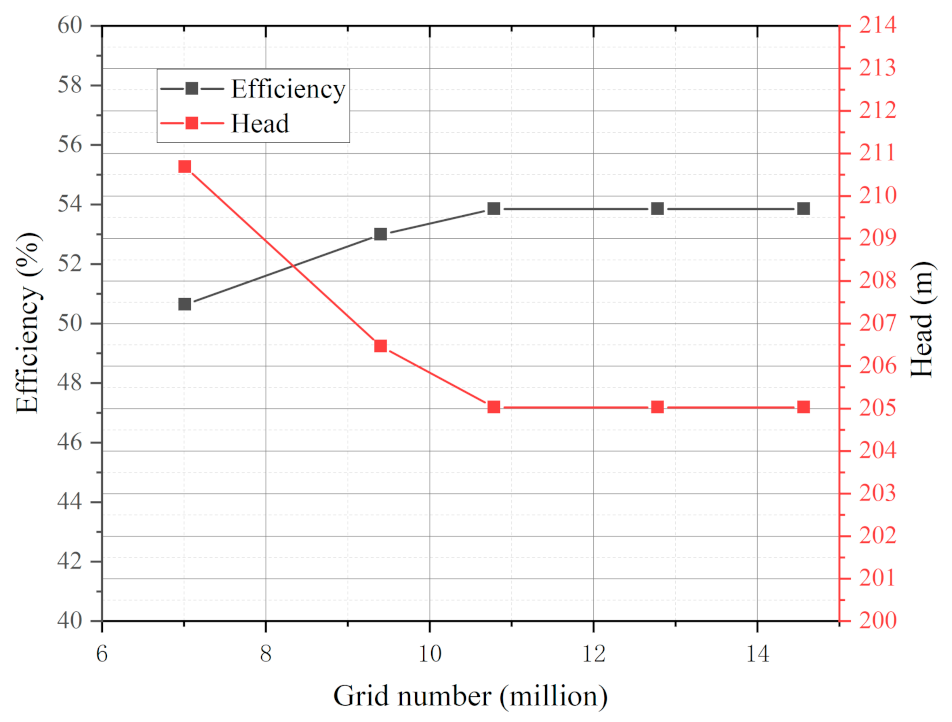
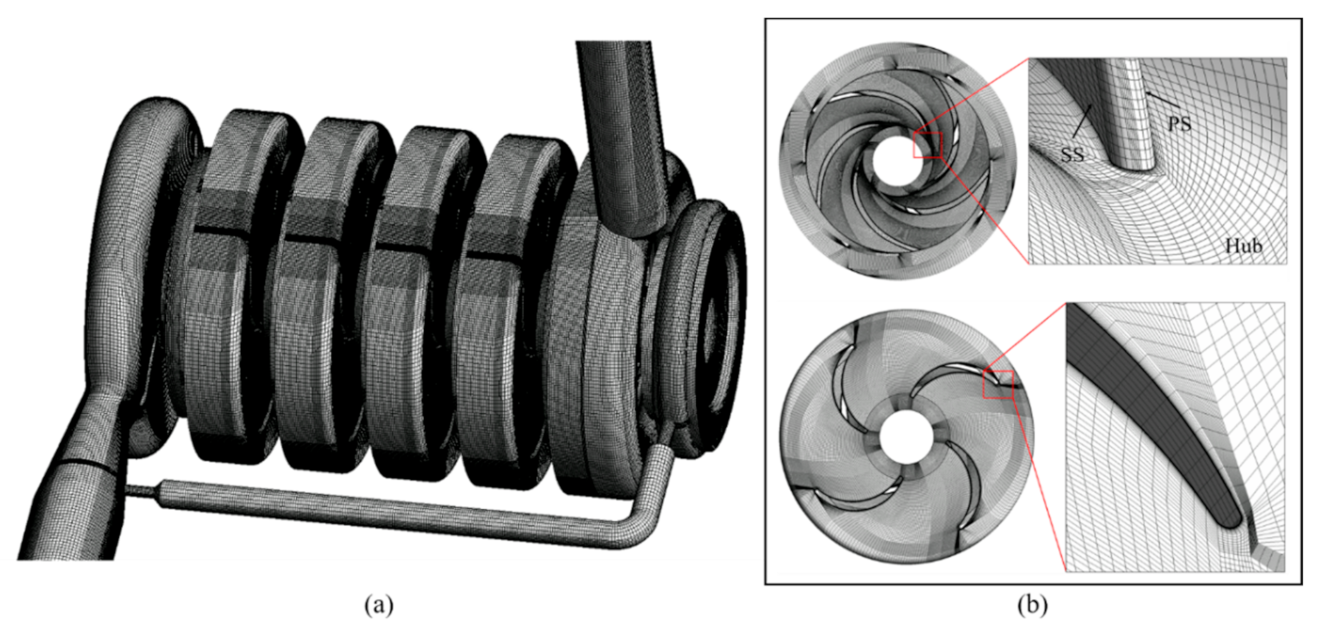
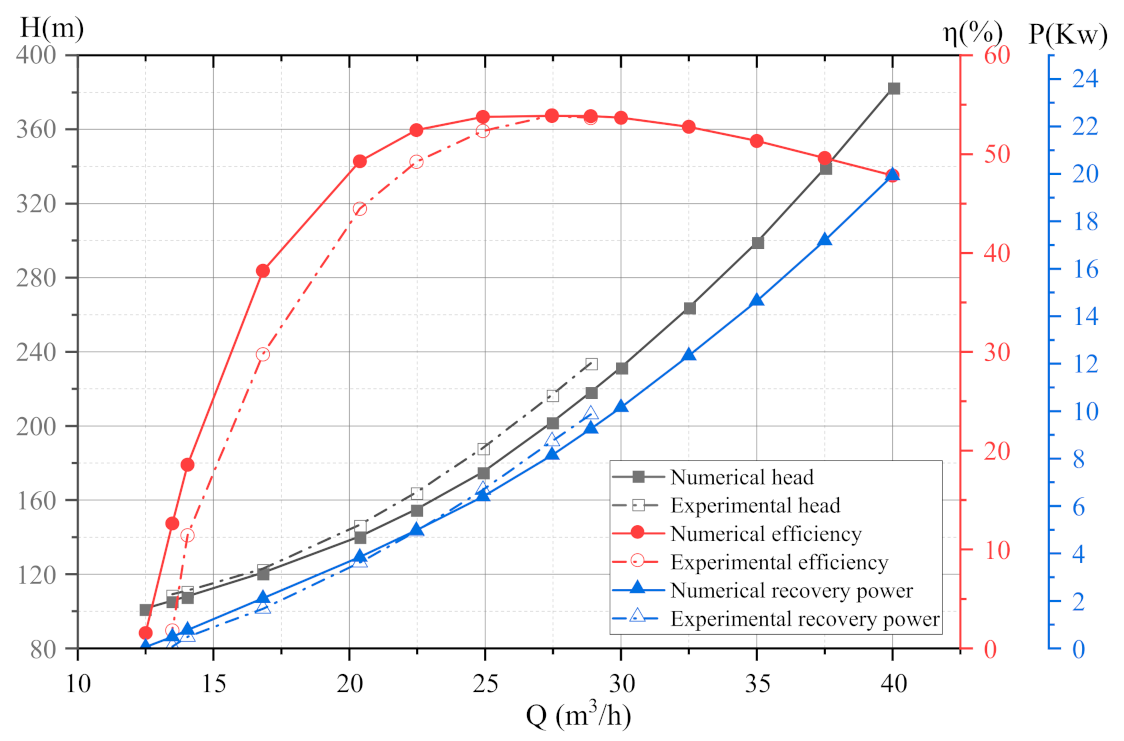



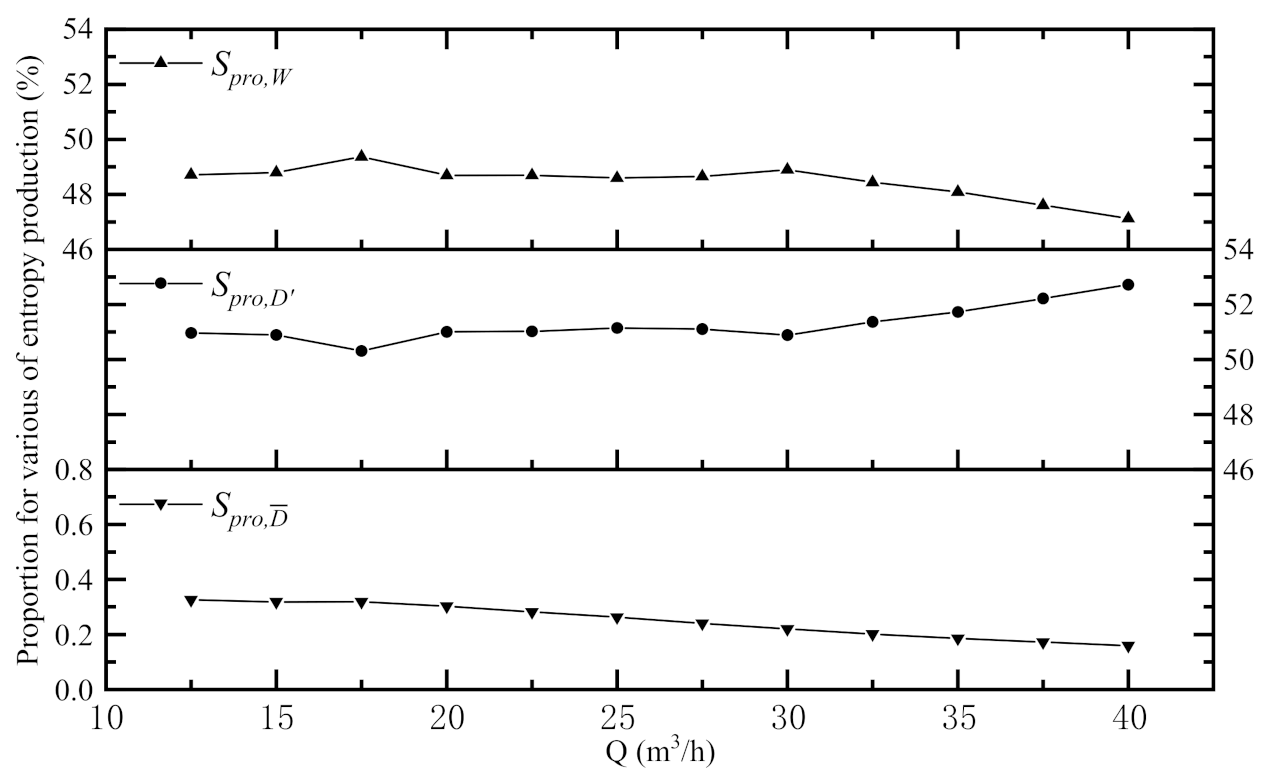

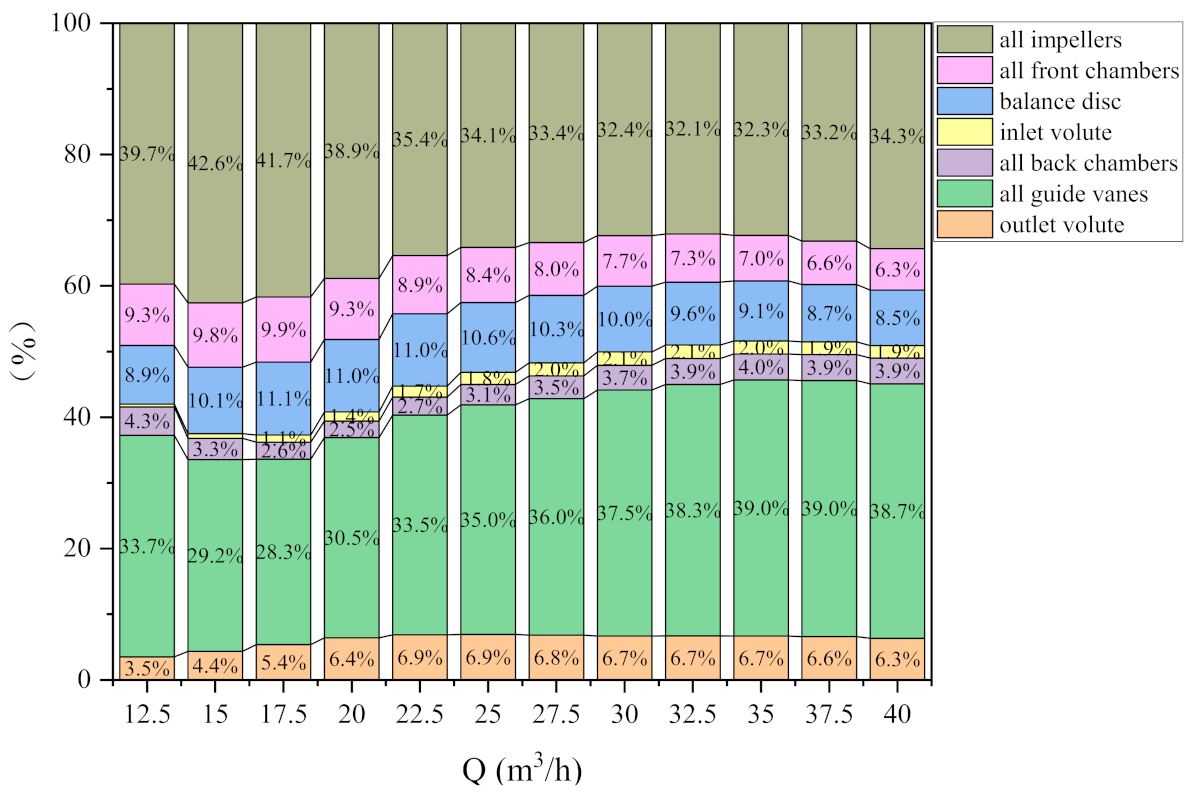

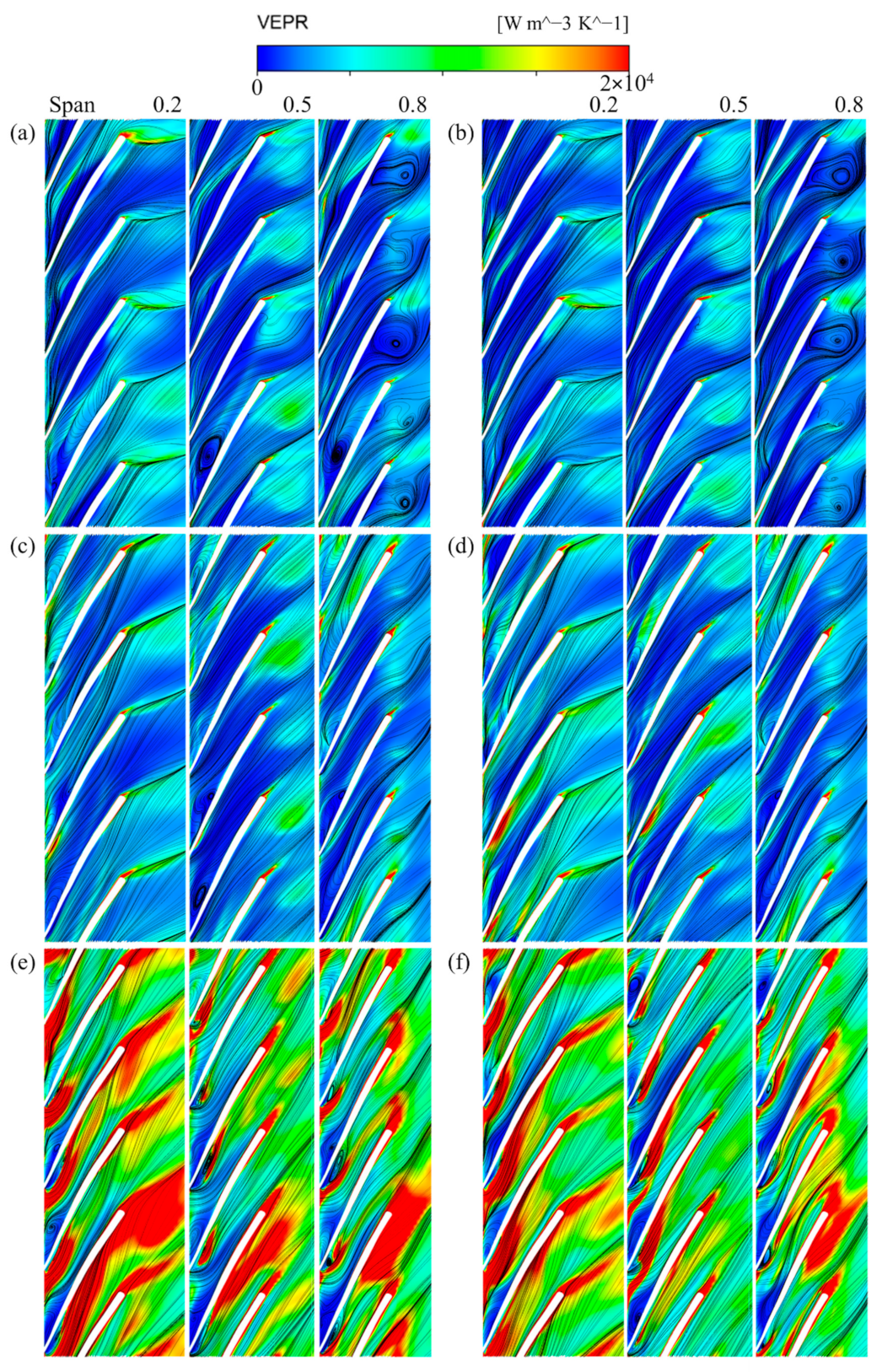

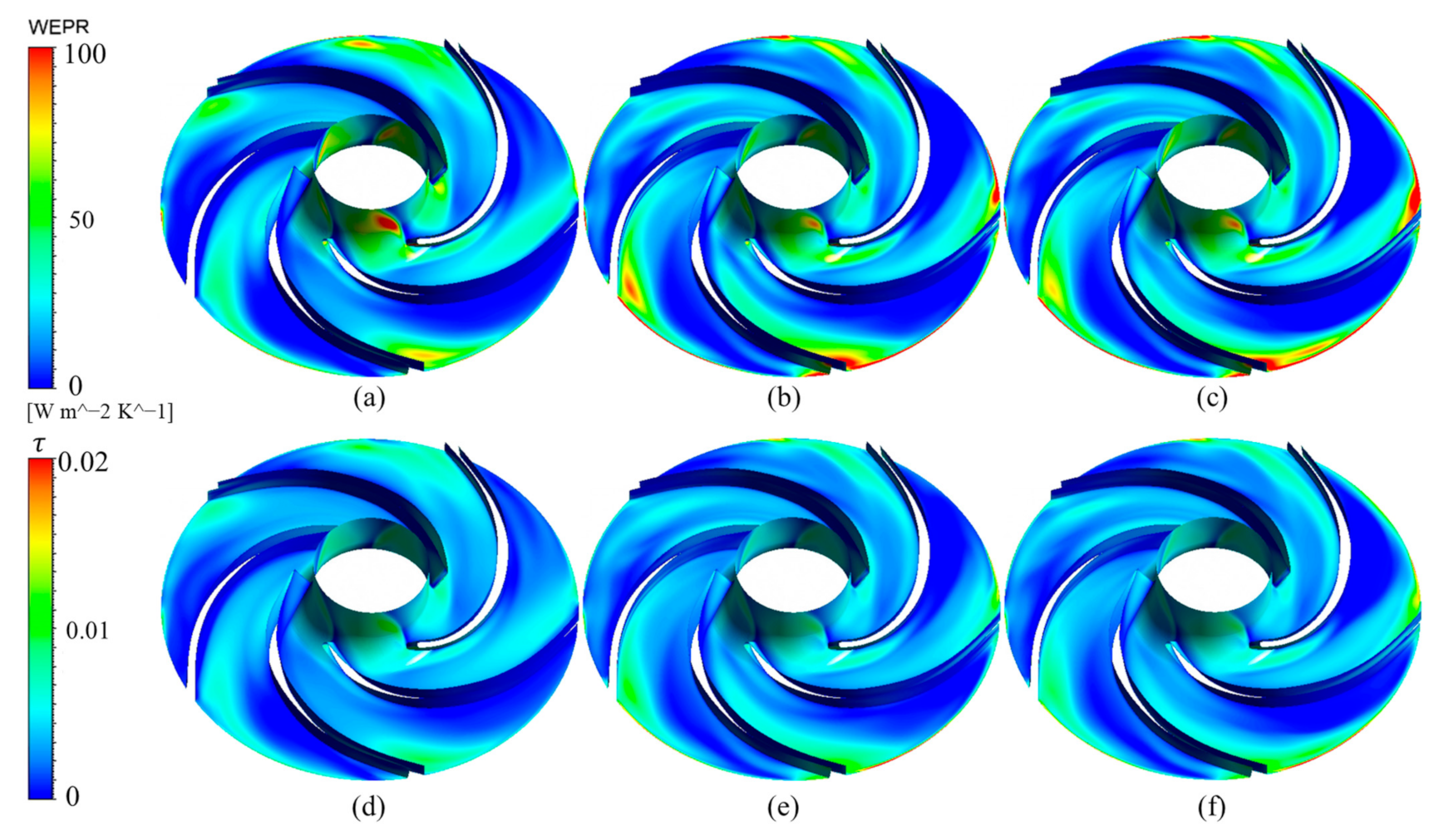
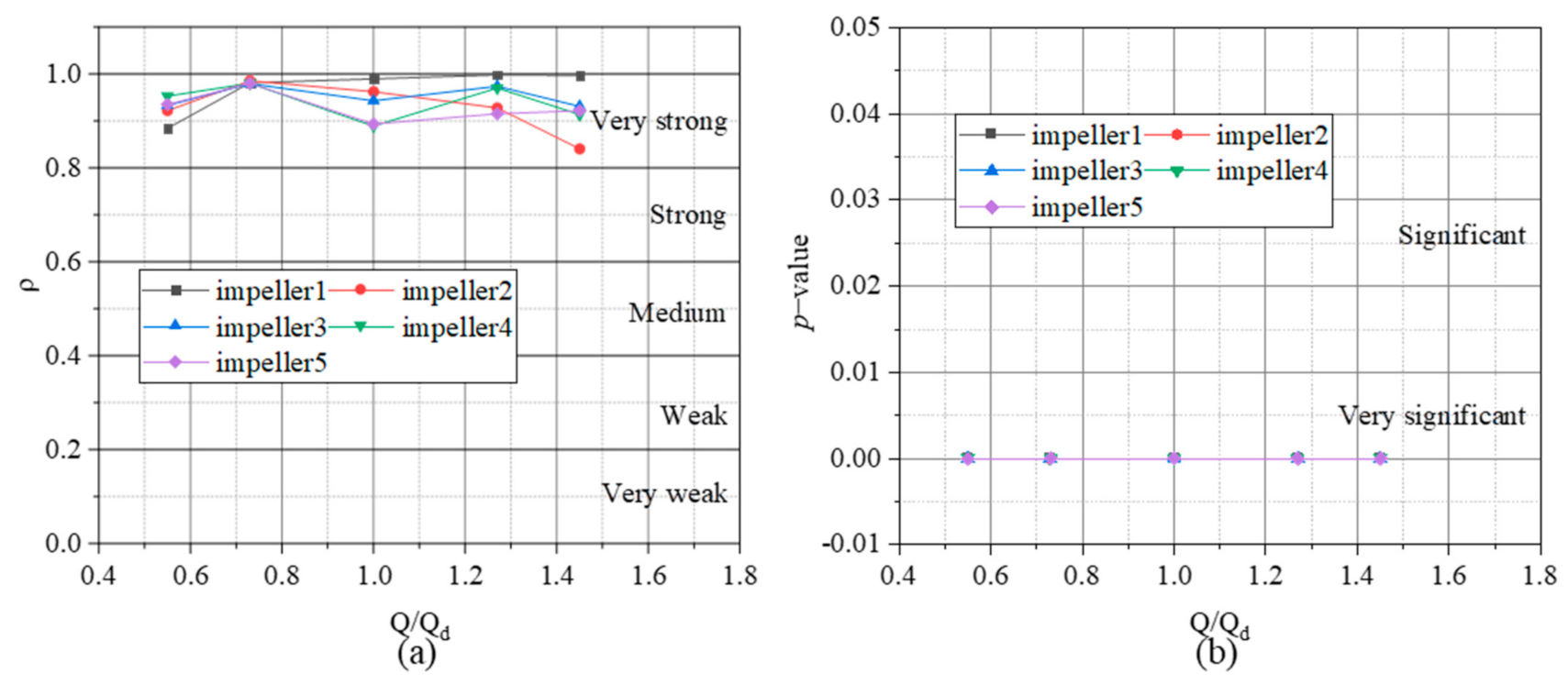
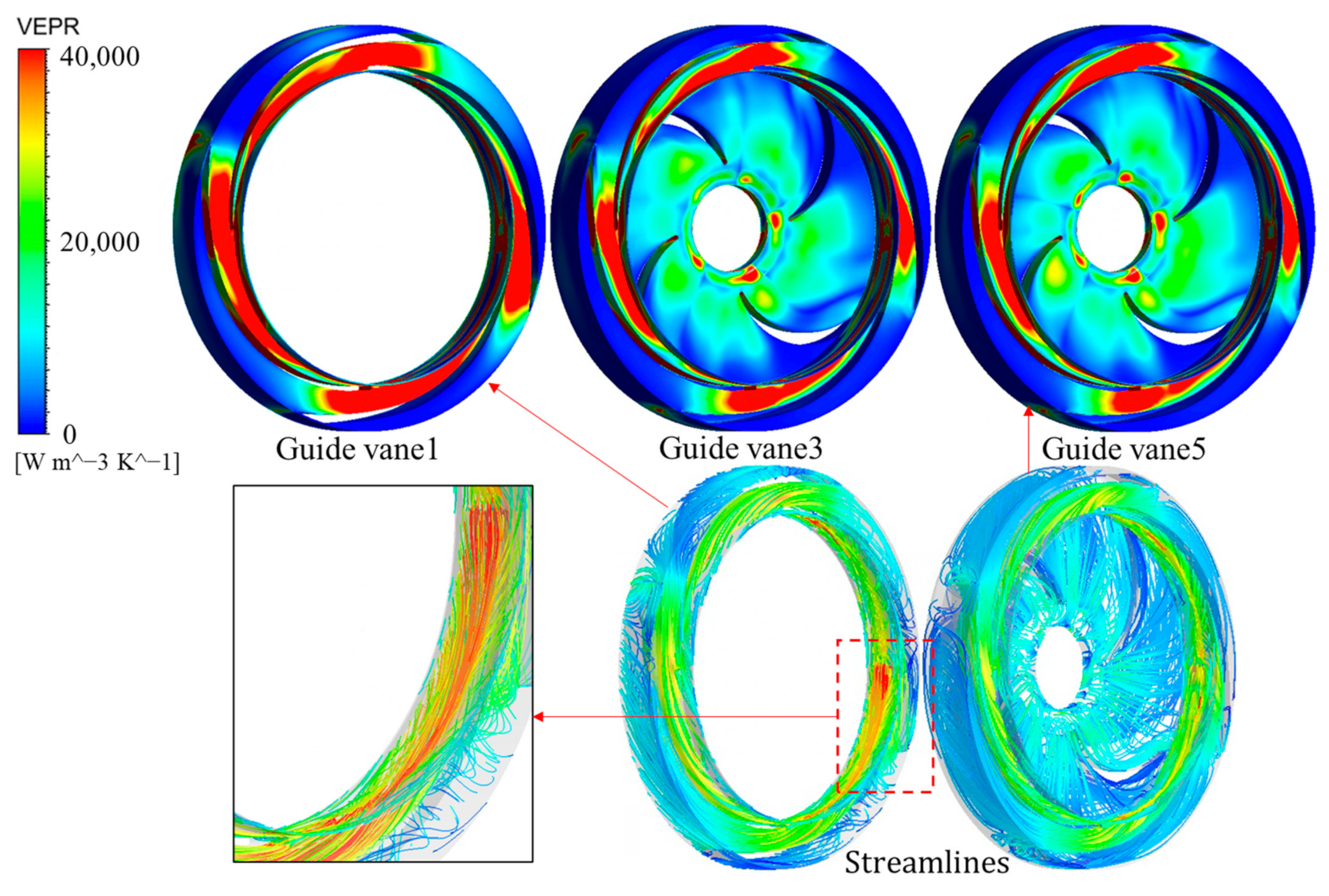


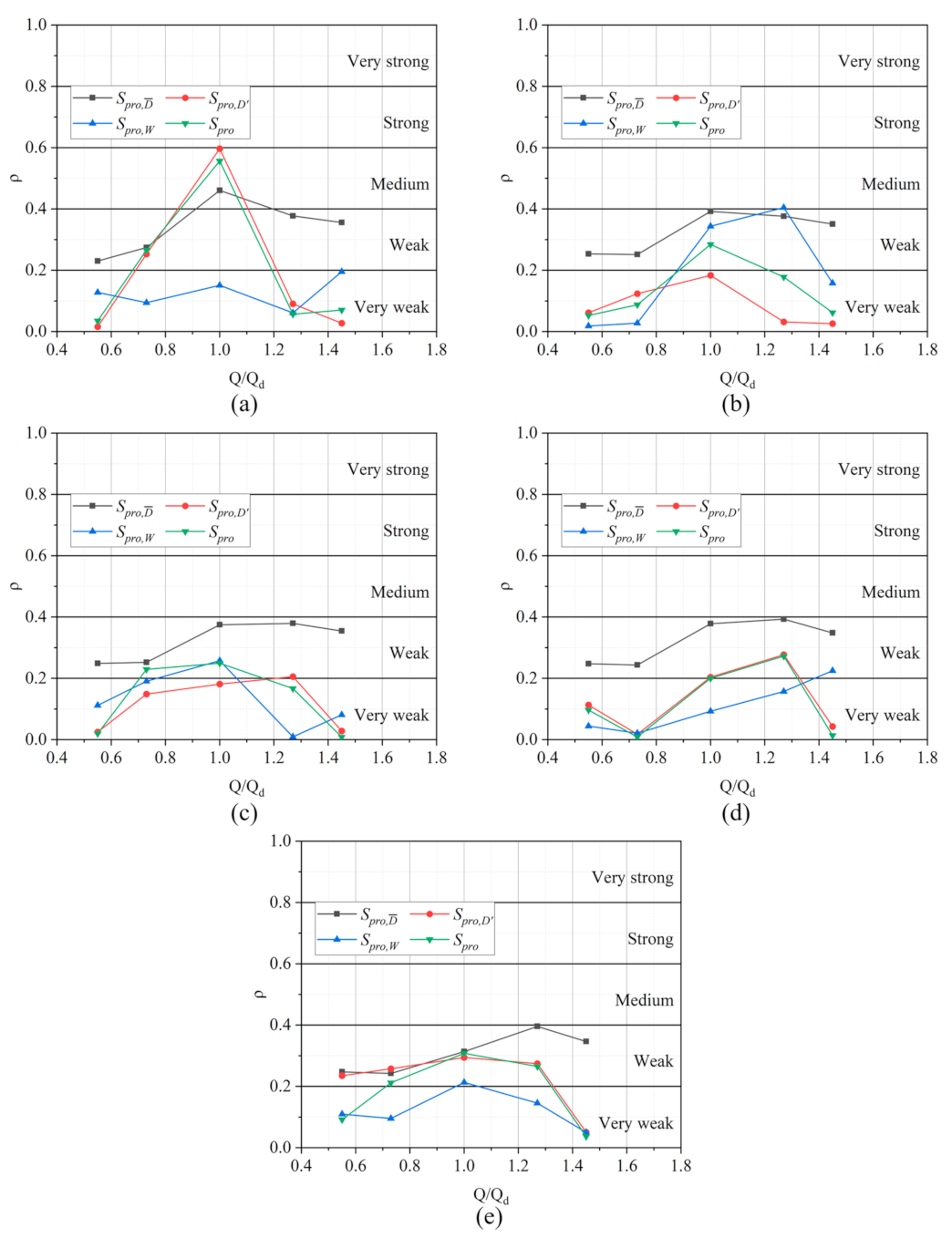


| Parson Correlation Coefficient Range | Correlation Level |
|---|---|
| 0.8–1.0 | Very strong correlation |
| 0.6–0.8 | Strong correlation |
| 0.4–0.6 | Medium correlation |
| 0.2–0.4 | Weak correlation |
| 0.0–0.2 | Very weak or no correlation |
| p-Value Range | Significance Level |
|---|---|
| <0.05 | Significant |
| <0.01 | Very significant |
| Measurement Apparatus | Range | Accuracy (%) |
|---|---|---|
| Flow meter | 2.121–106 m3/h | ±0.3 |
| Pressure transmitter 1 | 0–5 MPa | ±0.2 |
| Pressure transmitter 2 | 0–2.5 MPa | ±0.2 |
| Torque sensor | 0–70 N m | ±0.3 |
| Speed sensor | 0–13,000 rpm | ±0.01 |
| Parameter | Value |
|---|---|
| Nominal rotating speed n, r/min | 2900 |
| Nominal flow rate Qd, m3/h | 27.5 |
| Specific speed ns | 56.7 |
| Blade number Z | 5 |
| Impeller inlet diameter D1, mm | 146 |
| Impeller outlet diameter D2, mm | 56 |
| Impeller inlet width b, mm | 6 |
| Inlet volute diameter, mm | 40 |
| Outlet volute diameter, mm | 50 |
| Blade inlet angle β, deg | 27 |
| Parameters | |||
|---|---|---|---|
| Number of cells (million) | N1/N2/N3 | 14.6/10.8/7.0 | 14.6/10.8/7.0 |
| Grid refinement factor | r21/r32 | 1.106/1.156 | 1.106/1.156 |
| Computed variables | 203.01/202.46/201.49 | 54.01/53.87/53.59 | |
| Apparent order | P | 1.647 | 2.654 |
| Extrapolated value | 206.65 | 54.94 | |
| Approximate relative error | 0.27% | 0.26% | |
| Extrapolated relative error | 1.76% | 1.69% | |
| Grid convergence index | 1.87% | 1.06% |
Publisher’s Note: MDPI stays neutral with regard to jurisdictional claims in published maps and institutional affiliations. |
© 2022 by the authors. Licensee MDPI, Basel, Switzerland. This article is an open access article distributed under the terms and conditions of the Creative Commons Attribution (CC BY) license (https://creativecommons.org/licenses/by/4.0/).
Share and Cite
Ye, S.; Li, X.; Zhu, Z.; Li, L.; Lin, T. Numerical Study of the Energy Flow Characteristics of Multi-Stage Pump as Turbines. Processes 2022, 10, 2488. https://doi.org/10.3390/pr10122488
Ye S, Li X, Zhu Z, Li L, Lin T. Numerical Study of the Energy Flow Characteristics of Multi-Stage Pump as Turbines. Processes. 2022; 10(12):2488. https://doi.org/10.3390/pr10122488
Chicago/Turabian StyleYe, Sikun, Xiaojun Li, Zuchao Zhu, Linmin Li, and Tong Lin. 2022. "Numerical Study of the Energy Flow Characteristics of Multi-Stage Pump as Turbines" Processes 10, no. 12: 2488. https://doi.org/10.3390/pr10122488
APA StyleYe, S., Li, X., Zhu, Z., Li, L., & Lin, T. (2022). Numerical Study of the Energy Flow Characteristics of Multi-Stage Pump as Turbines. Processes, 10(12), 2488. https://doi.org/10.3390/pr10122488






